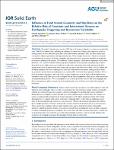Influence of Fault System Geometry and Slip Rates on the Relative Role of Coseismic and Interseismic Stresses on Earthquake Triggering and Recurrence Variability
| dc.contributor.author | Sgambato, C | |
| dc.contributor.author | Faure Walker, JP | |
| dc.contributor.author | Roberts, GP | |
| dc.contributor.author | Mildon, ZK | |
| dc.contributor.author | Meschis, M | |
| dc.date.accessioned | 2024-01-24T12:26:34Z | |
| dc.date.available | 2024-01-24T12:26:34Z | |
| dc.date.issued | 2023-11-01 | |
| dc.identifier.issn | 2169-9313 | |
| dc.identifier.issn | 2169-9356 | |
| dc.identifier.other | ARTN e2023JB026496 | |
| dc.identifier.uri | https://pearl.plymouth.ac.uk/handle/10026.1/21961 | |
| dc.description.abstract |
We model Coulomb stress transfer (CST) due to 30 strong earthquakes occurring on normal faults since 1509 CE in Calabria, Italy, including the influence of interseismic loading, and compare the results to existing studies of stress interaction from the Central and Southern Apennines, Italy. The three normal fault systems have different geometries and long‐term slip‐rates. We investigate the extent to which stress transfer can influence the occurrence of future earthquakes and what factors may govern the variability in earthquake recurrence in different fault systems. The Calabrian, Central Apennines, and Southern Apennines fault systems have 91%, 73%, and 70% of faults with mean positive cumulative CST in the time considered; this is due to fewer faults across strike, more across strike stress reductions, and greater along‐strike spacing in the three regions respectively. In regions with close along strike spacing or few faults across strike, such as Calabria and Southern Apennines, the stress loading history is mostly dominated by interseismic loading and most faults are positively stressed before an earthquake occur on them (96% of all faults that ruptured in Calabria; 94% of faults in Southern Apennines), and some of the strongest earthquakes occur on faults with the highest mean cumulative stress of all faults prior to the earthquake. In the Central Apennines, where across strike interactions are the predominant process, 79% of earthquakes occur on faults positively stressed. The results highlight that fault system geometry plays a central role in characterizing the stress evolution associated with earthquake recurrence. | |
| dc.language | en | |
| dc.publisher | American Geophysical Union (AGU) | |
| dc.subject | Coulomb stress transfer | |
| dc.subject | fault interaction | |
| dc.subject | earthquake triggering | |
| dc.subject | propagating earthquake sequence | |
| dc.subject | fault system geometry | |
| dc.title | Influence of Fault System Geometry and Slip Rates on the Relative Role of Coseismic and Interseismic Stresses on Earthquake Triggering and Recurrence Variability | |
| dc.type | journal-article | |
| dc.type | Article | |
| plymouth.issue | 11 | |
| plymouth.volume | 128 | |
| plymouth.publication-status | Published | |
| plymouth.journal | Journal of Geophysical Research: Solid Earth | |
| dc.identifier.doi | 10.1029/2023jb026496 | |
| plymouth.organisational-group | |Plymouth | |
| plymouth.organisational-group | |Plymouth|Faculty of Science and Engineering | |
| plymouth.organisational-group | |Plymouth|Faculty of Science and Engineering|School of Geography, Earth and Environmental Sciences | |
| plymouth.organisational-group | |Plymouth|REF 2021 Researchers by UoA | |
| plymouth.organisational-group | |Plymouth|Users by role | |
| plymouth.organisational-group | |Plymouth|Users by role|Academics | |
| plymouth.organisational-group | |Plymouth|REF 2021 Researchers by UoA|UoA07 Earth Systems and Environmental Sciences | |
| plymouth.organisational-group | |Plymouth|Users by role|Researchers in ResearchFish submission | |
| plymouth.organisational-group | |Plymouth|REF 2028 Researchers by UoA | |
| plymouth.organisational-group | |Plymouth|REF 2028 Researchers by UoA|UoA07 Earth Systems and Environmental Sciences | |
| dcterms.dateAccepted | 2023-10-16 | |
| dc.date.updated | 2024-01-24T12:26:33Z | |
| dc.rights.embargodate | 2024-1-27 | |
| dc.identifier.eissn | 2169-9356 | |
| rioxxterms.versionofrecord | 10.1029/2023jb026496 |


